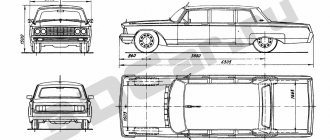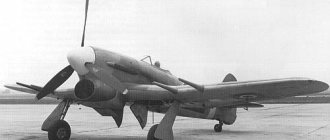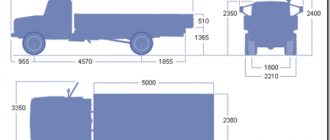GAZ 61 is a Soviet all-terrain passenger vehicle with an all-wheel drive system. The GAZ 61 73 brand became the world's debut all-wheel drive passenger car in a closed sedan body.
When the Great Patriotic War was going on, the GAZ 61 73 vehicle was actively used as a headquarters model for the high command of the RKKF. In total, the plant in Gorky produced no more than 200 cars of this type. The entire GAZ model range.
Car history
The 61st model was created in 1938. The Grachev design bureau worked on it, where they were looking for a replacement for the overly complex and not so passable three-axle GAZ 21 Experienced car with a 6x4 wheel arrangement. The design of the off-road vehicle was entrusted to Lependin, Borisov, Zislin, Kirsanov, Kosktin, Kuzin, Mozokhin, Pimenov and Podolsky.
When creating the car, they began researching the American-made Marmont-Harrington, which was an all-wheel drive sedan on the Ford V8 platform. By the end of the 1930s, a considerable number of countries began to produce off-road vehicles with a pair of drive axles.
GAZ-21 Experienced
In the Soviet Union, the automobile plant in Gorky became a pioneer in the design of passenger cars with increased cross-country ability. The country needed such machines during the development of new areas, on construction sites, in rural areas and in the army. In the middle of the summer of 1938, technical specifications were issued, and already in September they began to design an all-wheel drive version of the new car marked “61”.
GAZ-61 worked as a vehicle for many high-ranking people in the Soviet Union.
Before the height of the war, the situation was very tense - it was necessary to work in a short time, the design was given a matter of months and weeks. Despite the fact that the vehicle was initially planned to be produced in an open body (phaeton), its mass production was launched as the GAZ 51 73 model.
Where was the all-metal sedan body from the car marking 11-73, which was the debut model of a comfortable SUV with a closed “sedan” body. Already in the summer of 1939, the prototype began to undergo testing. They lasted all summer and autumn. The sedan reached speeds of up to 107.5 kilometers per hour, while spending about 14 liters of gasoline per 100 kilometers.
The designers were able to use, in general, vehicle parts that were produced in series. But we designed the front axle from scratch along with the transfer case. The chassis, along with the body, brakes and electrical equipment, was used from the GAZ 11 40 phaeton.
The four-speed gearbox is from the GAZ-MM lorry. The prototype had a Dodge D5 power unit, after which a domestically produced engine was installed. The first open-top off-road models were purchased by Marshal Voroshilov, generals Zhukov, Tyulenev, Meretskov and Pavlov.
The summer of 1940 made it possible to present the car at the All-Union Agricultural Exhibition among the most preferred examples of Soviet automobile production. Its serial production was planned for the same year. With the help of an all-wheel drive system, a solid reserve of engine power, an increased gear ratio in the gearbox, tires with a specialized profile and a frame height increased by 150 millimeters.
The newest vehicle overcame inclines on unpaved surfaces that not any tracked model can overcome - up to 43 degrees. The model was not afraid of sand, rainy soil, or snow (up to 0.4 m). Moreover, the GAZ-61 coped with towing a trailer whose weight reached 700 kg.
The log was not a problem, the car moved over it, even if its diameter was 0.37 m. It is quite interesting that the model could even drive up the stairs - tests proved this. Moreover, they were carried out not just somewhere else, but at the iconic base of the automobile plant in the city of Gorky. The approach angle was 30 degrees, and the sedan rose easily and in a calm manner.
They wanted to produce the newest model in three variations that best suited the needs of the army. We have not forgotten about the national economy. The result was a “phaeton” body, a closed basic “sedan” body and a semi-truck “pickup”.
In those years, a better light off-road armored vehicle than the GAZ-61-73 simply did not exist. Due to the increased ground clearance, the car was not afraid of almost anything.
Since the harsh winter of 1941 was approaching, they decided to send open-top vehicles in the debut batch to the Moscow tank repair plant No. 101, where they began to install sedans with closed bodies from GAZ 11 73. It was with this appearance that the car came to us.
The small artillery tractor GAZ 61 417 was immediately equipped at the enterprise with an anti-tank 57-mm cannon, where there was a transport limber, and sent to the front in the Moscow region.
It turns out that this is how the availability of a high-speed and maneuverable tank destroyer appeared, and only a small number of serial production did not provide the opportunity for this vehicle to demonstrate its full strength. Production of the 417th model was stopped in 1942 due to a shortage of six-cylinder power units and body parts.
And GAZ 61 73 was completed in 1945. It is generally accepted that this sedan vehicle carried Marshal of the Soviet Union, twice Hero of the Soviet Union, Ivan Stepanovich Konev.
Model development
GAZ-61 was created in 1938. The design and development of the vehicle was carried out by the Grachev Design Bureau. The engineers were faced with the task of finding a worthy replacement for the complex and clumsy three-axle predecessor GAZ M-21 with a 6*4 wheel arrangement. The design was entrusted to a team of designers who began work with a study of the American Marmont-Harrington sedan.
In the 1930s, many automakers around the world began to develop all-wheel drive off-road vehicles. The USSR also needed similar equipment, which was required for the development of virgin lands, in construction and in the army. In the domestic space, the Gorky Automobile Plant became a pioneer in the development of such cars.
Interior
Despite the fact that the body turned out to be closed, the level of comfort ended there. The car didn't even have a stove, but there was a cigarette lighter and an ashtray in the middle of the dashboard. By the way, the latter is all made of metal and has a green color, which once again proves the purpose of this car.
There is a large three-spoke steering wheel, which, naturally, is devoid of any amplifiers. The rim turned out to be thin, but it does not block the road. Behind it is the dashboard. The latter is made in the same style as a regular Emka, but they also decided to add an oil pressure gauge, because the engine here is subject to increased loads.
On the left there is a speedometer, on which the maximum value is 140 km/h, but it is clear that no one talked about such a speed. There is a kilometer counter. On the right, in a round frame, there is a fuel, oil, water level sensor and an ammeter. Everything is quite clear and the data is easy to read.
On the right there was a place for the ignition key socket. And even further to the right you can see a small glove compartment. The 4-speed manual transmission shift lever is located on the floor, and the transfer case is engaged using a lever under the dash. The door cards were covered with fabric upholstery on top of the metal.
On the front door you can open the window for ventilation, which also applies to the rearmost window. Both the front and rear sofas turned out to be very soft, which are in no way inferior to those at home.
There is plenty of free space above your head and in front of your feet. But when compared with current cars, the interior turned out to be a little narrow and quite simple. You can see a transmission tunnel on the floor. The interior has almost no plastic.
GAZ-11-73 - a sedan with a new, more powerful engine
GAZ-11-73
In 1938, during the process of operational testing of experimental GAZ-M1 with a Dodge D5 engine, changes and improvements were constantly made to the design of their chassis, mechanical brakes, suspension and steering, which resulted in the new GAZ-M-11 chassis with a six-cylinder GAZ-11 engine, simplified front axle and swing arms, longer springs for better ride quality, double-acting linkage shock absorbers, semi-centrifugal clutch and a new radiator. In 1939, these prototypes received new radiator trim, hood sides and bumpers and were subsequently put into mass production under the GAZ-11-73 designation.
A 3-speed gearbox (three speeds forward and one in reverse) and a gasoline, in-line, six-cylinder, lower valve engine with a volume of 3.485 liters and a power of 76 hp at 3400 rpm. A water cooling radiator was mounted in front of the engine. To transmit torque, a single-plate, dry, centrifugal clutch was used. Electrical equipment was 6 volts. The tank was located in the rear overhang of the frame, and fuel was supplied to the carburetor using a fuel pump.
The front axle of the GAZ-11-73 was suspended from the frame using a dependent suspension on longitudinal semi-elliptic springs with anti-roll bar and double-acting hydraulic lever-piston shock absorbers, and the rear axle was suspended using a dependent suspension on longitudinal semi-elliptic springs and double-acting hydraulic lever-piston shock absorbers actions. The rear axle had a bevel gear and was connected to the gearbox using a cardan shaft, which was enclosed in a pipe and rigidly attached to the main gear housing. Disc wheels with rubber tires measuring 7.00-16 were attached to the car axles. The service foot drum brake was mechanically actuated and acted on all wheels, and the hand parking brake was mechanically actuated and also acted on the rear wheels from a hand lever with a pistol-type knob located under the instrument panel.
GAZ-11-73
A closed four-door all-metal body was installed on the chassis, the only wooden elements of which were the frame in the central part of the roof and the side roof bars to which the door pillars were attached. The roof of the car was made with a wooden insert covered with tarpaulin, since at that time Soviet industry did not have the ability to produce an all-metal sheet of this size. To facilitate access to the engine compartment, opening sides were provided on each side of the body. The doors were hung on front hinges. A single wiper was mounted on the upper frame of the windshield in front of the driver's face to facilitate visibility in bad weather. The windshield wiper had a vacuum drive, the hose of which was connected to the carburetor inlet manifold. Metal bumpers served to protect the body from minor damage. The spare wheel was attached to the rear wall of the car and covered with a removable metal casing. At night, the road was illuminated by two electric headlights and two side lights with brake lights, which were attached to the wings. Also, side lights were located on top of the front fenders. Footrests were located between the front and rear fenders to facilitate entry into the car. The bodies were painted black, brown, dark blue or cherry.
In the interior of the GAZ-11-73 there was a modified instrument panel with a starter button, which was painted to resemble wood.
The car could reach a maximum speed of up to 120 km/h, while fuel consumption was 15 liters per 100 km.
The overall dimensions and weight of the car were:
- length – 4670 mm;
- width – 1770 mm;
- height – 1775 mm;
- wheelbase – 2845 mm;
- curb weight – 1455 kg;
- capacity – 5 people.
The GAZ-11-73 was produced serially from 1941 to 1946, when it was replaced by the GAZ-M20 Pobeda. During this period, 1142 cars were manufactured: 1941 - 107 copies, 1942 - 2 copies, 1943 - 3 copies, 1945 - 286 copies, 1946 - 744 copies. These vehicles were sent to the front, where they were used as command vehicles for senior officers.
In 1940, a pickup truck was built on the GAZ-11-73 chassis, which received the designation GAZ-11-415.
GAZ-11-73
Specifications
Power unit
To propel this sedan with all-wheel drive, a carburetor four-stroke six-cylinder lower valve engine with a volume of 3.48 liters was installed, which produced 76 horsepower.
This power unit is made of cast iron. Its power and torque were quite enough to overcome off-road conditions and even transport military trailers. Fuel consumption was stated at 15 liters per 100 km. The maximum speed was 107 km/h.
Transmission
Such a powerful engine was synchronized with a 4-speed manual gearbox. The clutch is a single-plate dry semi-centrifugal.
Chassis of GAZ-61
Suspension
Both the front and rear suspension were dependent, with transverse springs installed. Installing the front axle, unlike the rear, was practically a debut job (for the first time at the Gorky Automobile Plant). Initially, Rzeppa CV joints were installed, and later Bendix-Weiss were installed. The ride height was simply impressive, it was a real SUV - 210 mm.
Brake system
Drum brake mechanisms were used as a braking system, the load on which was heavy, because the car weighed about 2,000 kg.
Specifications
| Modification | GAZ 61-73 |
| Body type | 4-door sedan |
| Number of places | 5 |
| Length | 4800 mm |
| Width | 1770 mm |
| Height | 2080 mm |
| Base | 2845 mm |
| Ground clearance | 210 mm |
| Curb weight | 1650 kg |
| Total weight | 2150 kg |
| Drive unit | full (plug-in) |
| Razdatka | 1-st. |
| Transmission | 4-st. fur. |
| engine's type | carburetor |
| Engine capacity | 3.485 l |
| Number of cylinders | 6 (in-line) |
| Engine power | 85/3600 hp/rev. |
| Torque | 220/2200 N*m/rev. |
| Max. speed | 107 km/h |
Description of design
At the heart of the GAZ-61 car chassis is a frame made of stamped elements. Carbon steel 3 mm thick was used to produce parts. The vehicle's axles are mounted on springs with additional shock absorbers.
The steering mechanism of the GAZ-61 car consists of a worm with a globoidal groove and a double roller. The gear ratio is 16.6, independent of the position of the steering wheel. The power unit is installed on floating supports. The closed body of the GAZ-61 car is designed for 4 people; the design does not provide for a heating system. Ventilation of the GAZ-61 interior is carried out through folding windshields and lowering and rotating elements in the doors.
The front sofa is adjustable according to the distance from the pedals.
The GAZ-61 cars used a 6-cylinder lower valve GAZ-11 engine, equipped with an aluminum cylinder head, which increased the compression ratio to 6.5. The unit developed a power of 85 hp. The original DodgeD-5 could be installed on open cars, which served as the prototype for the GAZ-11. The American engine was distinguished by a slightly increased volume and dimensions of parts corresponding to the inch measurement system. The overseas brother developed a power of 87 hp.
Along with the engine, the Stromberg carburetor was copied, equipped with an accelerator pump and an economizer. The Soviet version of the unit received the designation K-23, the unit was used on all GAZ-61 vehicles built.
Modifications
GAZ-61 experienced (1939-1940) - an experimental model with an M1 phaeton body; GAZ-61-40 (1941) - a model with a “phaeton” body, a small batch was made for the senior command staff of the Red Army, in 1942 the open bodies were replaced with closed ones of the “M1” and “73” types. This model was 30 kg lighter than the GAZ-61-71, although, in addition to the main 60 liter gas tank, it also had a reserve tank with a capacity of 50 liters. In addition, two spare tires were installed in the front fender pockets; GAZ-61-73 (1941-1945) - a sedan, produced in small batches in 1942-1945. Model with a sedan body; GAZ-61-415 (1940) - a pickup truck with a closed cab, did not go into production; GAZ-61-417 (1941) - an all-wheel drive pickup truck with folding seats and a two-seater cab with a canvas top, produced in several hundred copies. This vehicle was used as an artillery tractor to tow 45 mm anti-tank guns.
War time
In the winter of 1941, they decided to transport open-top cars to a tank repair plant in Moscow. There they were converted into “sedans”. In addition, there were artillery tractors based on the model in question, which were equipped with a 57-mm anti-tank gun. Unfortunately, the limited serial production did not allow us to demonstrate all the capabilities of this technology. The production of tank destroyers was suspended due to a shortage of six-cylinder engines and body parts. The full production of modification 61-73 was completed in 1945.
Advantages and disadvantages
Pros of the car
- High-quality and reliable metal body;
- Powerful power unit;
- Good ride height;
- Tall and spacious interior;
- Comfortable and soft sofas;
- There is a cigarette lighter and an ashtray;
- Good maneuverability;
- Good dynamic characteristics;
- Rich story;
- Very few copies were produced;
- All-wheel drive system;
- Possibility of transporting trailers.
Cons of the car
- Large vehicle weight;
- There are no hydraulic boosters in the steering and braking system mechanisms;
- No seat belts;
- The steering wheel, like the seats, is not adjustable;
- There is no luggage compartment;
- There is no heater in the cabin;
- Small wheels;
- Narrow interior;
- There are a lot of iron parts, which was not very convenient in winter;
- Small batch production.
Chassis
The wheels were equipped with special tires with high tread of the “Ground-Grip” brand for all-terrain vehicles. The chassis of the car met the requirements of harsh off-road use; the spring-type suspension was supplemented with oil shock absorbers. The brake system of the machine was mechanical, adjustable rods and flexible drives worked. All wheels were equipped with drum mechanisms with eccentrics.
The car could climb up to 43 degrees. Without acceleration, the car began to move up an incline of 15 degrees. The GAZ-61 passed the sandy hill at 30 degrees. The depth of the ford was 82 cm. The car could pass through snow cover 40 centimeters high. The speed of the car with a full load of 500 kilograms was 107 km/h.
In July 1940, GAZ-61 became a participant in the All-Union Agricultural Exhibition at VDNH in Moscow as the best example of the domestic automotive industry.
Let's sum it up
Summing up the results of the GAZ-61, I would like to say that the design staff managed to make a real breakthrough in such a short period of time on a global scale. It took a lot of effort to make the first all-wheel drive sedan with increased ground clearance, which was almost not afraid of anything.
It is clear that we can talk about the lack of the proper level of comfort, because they carried high-ranking people of the USSR, but we should not forget at what time this car was created. It was important that it be made quickly and that it could go places that most cars couldn't go.
For this purpose, a powerful power unit for those times was installed, which was perfectly combined with a 4-speed gearbox and all-wheel drive system. Moreover, engineers have provided for the possibility of transporting military equipment.
Therefore, this model was in great demand, as it could also transport ammunition, as well as personnel. But, especially in winter, the heater was sorely lacking. There were three body models in total - a sedan, a pickup truck and a phaeton. But due to internal problems and the restructuring of the Gorky Automobile Plant to other automobile models, production of the 61st brand was stopped.
In such a short period of time, the sedan became a real celebrity, because marshals and even a hero of the Soviet Union drove them. Today the GAZ-61 can be found restored in some places, because very few copies have survived to this day.
We advise you to read the article: GAZ - the history of car production
Tests
In the summer of 1940, the GAZ-61 car was presented at the All-Union Exhibition among the most promising Soviet-made vehicles. Soon it was planned to begin serial production of the model.
The new product, thanks to all-wheel drive, solid engine power, specialized tires and an oversized frame, easily covered climbs on a dirt road that were beyond the power of tracked models. The car was not afraid of snow, sand, dirt, and could tow a trailer weighing up to 0.7 tons. GAZ-61 could drive up stairs and not notice logs with a diameter of up to 370 millimeters. The sedan easily rose at an approach angle of 30 degrees. It was planned to produce the new model in three versions: “sedan”, “phaeton”, “pickup”.
GAZ-61 photo
Read further:
It became known how much the Volvo S90 will cost in Russia
History of Soviet convertibles
The history of Moskvich 402 in detail
Buick history
Vehicle check service by VIN code











